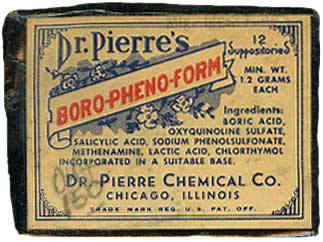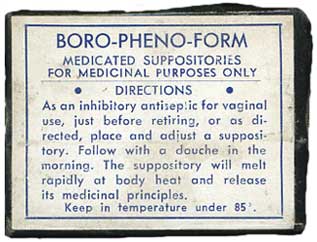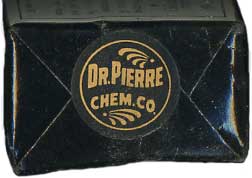More patent medicine
|
Small boxes of old American patent medicine
for women's diseases,
|
Murray &
Nickell Blue Cohosh Root | Murray &
Nickell Cotton Root Bark | Allaire Woodward
& Co. Oak Bark-White | Wampole's Vaginal
Cones with Picric Acid | Humphreys "31"
| Orange
Blossom Suppositories | Dr. Pierce's
Vaginal Tablets | Micajah's
Medicated Wafers | Santrex Formula
52T | Sedets
|
Dr. Pierre's Boro-Pheno-Form suppositories
 |
|
Many of these medicines contain acid, increasing the natural acidity of the vagina. Acid helps prevent dangerous organisms from thriving, like those that cause vaginitis. Naturally occurring Döderlein bacteria in the vagina make lactic acid (and it's in the ingredients on the box, above), helping keep it healthy. Menstruation decreases the acidity of the vagina, making it more susceptible to certain harmful organisms. But as a reader pointed out, the main use for these suppositories might have been to kill sperm, which sufficiently strong acid can do. Boric acid is a "chemical substance with mild antiseptic, antifungal, and antiviral properties," according to www.vitacost.com. Oxyquinoline sulfate is made from coal tar and "The manufacturer claims: it is externally used as a powerful nontoxic, noncaustic antiseptic and for use in treatment of gynecological infections (meritritis, vaginitis) as it restores the vaginal acid balance . . . . These claims are not currently supported by FDA classification . . . . There are no currently approved OTC uses for oxyquinoline sulfate, all formerly listed uses skin protectant or antifungal are classed as category II and not generally recognized as safe and effective or misbranded." (from http://www.ams.usda.gov/nop/NationalList/TAPReviews/Hydroxyquinoline.pdf.) (Coal tar was the first chemical associated with cancer, in 1775, among chimney sweeps in London.) Salicylic acid: "The major use of salicylic acid is in the preparation of its ester derivatives; since it contains both a hydroxyl (-OH) and a carboxyl (-CO2H) group, it can react with either an acid or an alcohol" (from http://www.bartleby.com). Http://www.wholehealthmd.com/refshelf/drugs_view/1,1524,399,00.html writes that Methenamine kills bacteria in the urinary tract by forming ammonia and formaldehyde. Sodium phenolsulfonate "Has been used in tonsillitis and as an intestinal antiseptic; has no antiseptic properties," states (cryptically) http://www.biology-online.org. As a phenol I believe it's based on coal tar. Lactic acid: "Lactic acid is produced commercially for use in pharmaceuticals and foods, in leather tanning and textile dyeing, and in making plastics, solvents, inks, and lacquers" (from http://www.bartleby.com) and is also present in the vagina, helping to keep it acid and healthy. Chlorthymol, according to the German site http://www.pharmazeutische-zeitung.de/, is an antiseptic and fungicide - and I believe it is also based on coal tar. |
 |
| The box measures 2 1/8" x 1 5/8" x 1" (5.5 x 4 x 2.54 cm). |
 |
| The black material is
heavy and shiny; the two end pieces
(above) look like stickers. As you see
in the pictures, the material bulges
out, forming an irregular outline.
|
NEXT ···>
Murray & Nickell Blue
Cohosh Root | Murray
& Nickell Cotton Root Bark | Allaire Woodward & Co.
Oak Bark-White
| Wampole's Vaginal Cones
with Picric Acid | Humphreys
"31" | Orange
Blossom Suppositories | Dr. Pierce's Vaginal
Tablets
| Micajah's Medicated
Wafers | Santrex
Formula 52T | Sedets


